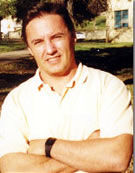CFIN/DNC Guest Talk: Professor David Poole
Professor David Poole from the Departments of Kinesiology, Anatomy and Physiology, Kansas State University, USA is visiting Aarhus and will give a CFIN/DNC guest talk
Info about event
Time
Location
Pathology Auditorium, AUH, Building 18, Nørrebrogade 44, 8000 Aarhus C
Organizer

The guest talk is entitled:
Muscle Microvascular Oxygen Delivery in Health and Disease: Data versus Dogma
and will take place on Monday 23 June 2014 at 15.00 in the Pathology Auditorium, Aarhus University Hospital, Building 18, Nørrebrogade 44, 8000 Aarhus C.
ALL ARE WELCOME.
ABSTRACT:
The capillary bed constitutes a vast surface facilitating exchange of O2, substrates and metabolites between blood and organs. In contracting skeletal muscle capillary blood flow and O2 diffusing capacity as well as O2 flux may increase two orders of magnitude above resting. Chronic diseases such as heart failure, diabetes and also sepsis impair these processes leading to compromised energetic, metabolic and ultimately contractile function. Among researchers seeking to understand blood-myocyte exchange in health and the bases for dysfunction in disease there is a fundamental disconnect between microcirculation specialists and many physiologists and physiologist clinicians. Whereas the former observe capillaries and capillary function directly (muscle intravital microscopy) the latter generally use indirect methodologies (e.g., post-mortem tissue analysis, 1- methyl xanthine, contrast enhanced ultrasound, permeability surface area product) and interpret their findings based upon August Krogh’s observations made nearly a century ago. “Kroghian” theory holds that only a small fraction of capillaries support red blood cell (RBC) flux in resting muscle leaving the vast majority to be “recruited” (i.e., initiate RBC flux) during contractions which would constitute the basis for increasing capillary exchange surface area and reducing capillary-mitochondrial diffusion distances. Today the entrenched “capillary recruitment” hypothesis is challenged by direct observations of capillaries in contracting muscle; something that Krogh and his colleagues could not do. Moreover, in the peer-reviewed scientific literature, application of a range of contemporary physiological technologies including intravital microscopy of contracting muscle, magnetic resonance and near infrared spectroscopy and phosphorescence quenching combined with elegant in situ and in vivo models suggest that the role of the capillary bed, at least in contracting muscle, is subserved without the necessity for de novo capillary recruitment of previously non-flowing capillaries. Thus a wealth of evidence calls for a radical revision of blood-muscle exchange theory to one in which most capillaries support RBC flux at rest and, during contractions, capillary surface area is “recruited” along the length of previously flowing capillaries. This occurs, in part, by elevating capillary hematocrit and extending the length of the capillary available for blood-myocyte exchange (i.e., longitudinal recruitment). Our understanding of blood-myocyte O2 and substrate/metabolite exchange in health and the mechanistic bases for dysfunction in disease demands no less.
